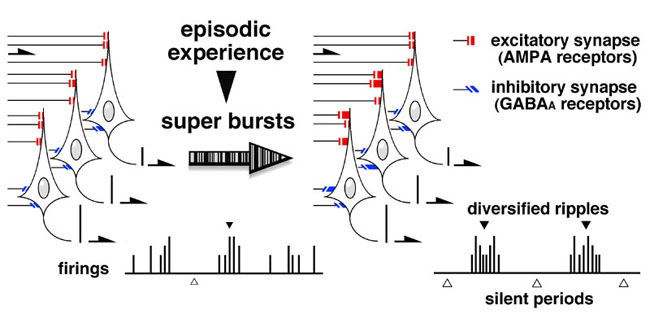| Research
Logic circuits require both excitatory and inhibitory synapses, and experience creates specific plasticity (2023.2). 
Our hypothesis on the early-learning process in CA1 pyramidal neurons (2019) We found episode-specific events of super bursts, synaptic plasticity, and ripple-like firings (300 Hz - 10 kHz). Experience-induced super bursts may create specific synaptic diversity and ripple-like firings. If this conceptualization is correct, we may decipher encrypted experience through the deep learning of the orchestrated ripple-like firings and synaptic plasticity in multiple CA1 neurons. (see Figure 7 in BioRxiv 2019)Previous version (2013) The hippocampus plays a central role to form new episodic memory in various species including humans (Scoville and Milner, J Neurol Neurosurg Psychiatry, 1957). The hippocampal neurons seem to process variety of information, such as spatial location (Wills et al, Science 2010), temporal information (Mitsushima et al, J Neurosci 2009), and emotional state (Chen et al, PLoS ONE 2009) within specific episodes (Gelbard-Sagiv et al, Science 2008). However, the critical mechanism how to sustain a piece of specific memory or what associates the memory fragment each other is still largely unknown. Since selective blockade of long-term potentiation (LTP) induction by NMDA receptor antagonist impairs hippocampal learning (Morris et al, Nature 1986), LTP has been considered as a cellular model of hippocampal memory (Bliss and Lomo, J Physiol 1973). In 2006, in vivo field EPSC recording study showed that hippocampal learning induces LTP in CA1 region of hippocampus (Whitlock et al, Science 2006). Further, we revealed that learning-dependent synaptic delivery of AMPA receptors into the CA3-CA1 synapses is required for hippocampal learning (Mitsushima et al, Proc Natl Acad Sci USA 2011). Since there is no tetanus electrode in brain, endogenous trigger and/or the mechanism inducing the learning-dependent LTP were unknown. I hypothesized acetylcholine (ACh) as an endogenous trigger of LTP, since the ACh release in the hippocampus increases during learning or exploration. Moreover, without electrode for tetanus stimulation, bath treatment of ACh agonist not only induces specific bursts (Fisahn et al, Nature 1998) but also forms LTP in CA1 region of hippocampal slices (Auerbach and Segal, J Physiol 1996). Based on the hypothesis, I found that i) cholinergic trigger drives learning-dependent synaptic plasticity at excitatory and inhibitory synapses and ii) learning requires the diversity of synaptic inputs in CA1 pyramidal neurons (Mitsushima et al, Nature Commun 2013). Our hypothesis of learning &
memory (2013)
Mitsushima D. Dai Mitsushima Mitsushima D. Dai Mitsushima Mitsushima D. Dai Mitsushima Mitsushima D. Dai Mitsushima |
